The Resource Management Institute's Global Symposium never disappoints, and this year's event was no exception. RMGS 2024, held on 23/24 April in Indianapolis, was a whirlwind of thought-provoking sessions, lively discussions, and networking opportunities—all centred around the future of resource management.
As someone passionate about this field, it was great to discover more about the latest insights and innovations from industry leaders and experts. Here’s a recap of the main themes that emerged:
- Accelerating resource management maturity
- The importance of forecasting for resource management precision
- Elevating resource management internally
- Trends in resource management technology
Read on for more about each one below...
Theme 1: Accelerating resource management maturity
One key theme that emerged across many talks at RMGS 2024 was the importance of accelerating resource management maturity. A standout session, led by Shannon McCarthy and Desiree Peyman from LMI, took us on their organisation's journey from the ground up. In one year, they accelerated their resource management program to an impressive 2.5 on the RM Maturity Model. They discussed the challenges they faced, from managing expectations and change to securing leadership buy-in.
David Cochran from Nutanix echoed similar sentiments in his session on leveraging AI to accelerate resource management maturity. As organisations face increasingly complex resourcing challenges, he made a case for using AI and machine learning to optimise resource allocation, enhance decision-making, and drive operational excellence.
Alison Driscoll from ProFinda and Sandy Stanfield from CohnReznick further explored this theme, sharing their insights on how AI-powered resourcing can impact profitability, employee experience, and tackle long-standing challenges like bench management.
Throughout these sessions, a common thread emerged: the path to resource management maturity isn’t linear. It requires a holistic approach; including culture, processes, governance, and a willingness to embrace innovation.
As our own blog on the resource management maturity model outlines, organisations typically progress through four distinct stages: manual, basic, connected, and strategic resource management. Each stage unlocks greater efficiency, cost savings, and strategic advantages, with the highest level enabling precise forecasting, AI-driven optimisation, and seamless integration across systems.
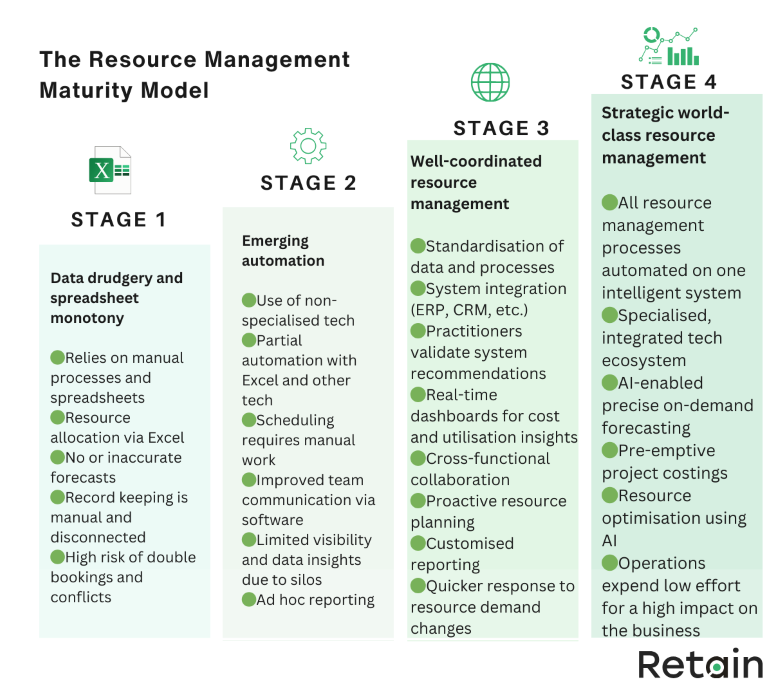
[Retain’s Resource Management Maturity Model]
The key (as emphasised by multiple speakers) is to honestly assess your current maturity level and develop a roadmap to reach the next stage. This may involve tackling foundational issues like system integration, introducing specialised resource management software, providing training and support, and consistently measuring key metrics.
By committing to this journey, firms can transform resource management from a manual task to a strategic function that drives long-term value. (Check out our full blog on the resource management maturity model for more insights.)
Theme 2: The importance of forecasting for resource management precision
Another major theme that took centre stage at RMGS 2024 was the importance of precision resource forecasting—a critical capability that, according to RMI research, remains one of the biggest inhibitors to effective resource management.
A panel discussion, moderated by Marc Lacroix of RTMC, dove into accelerating resource management excellence through accurate forecasting. Panellists Gary Ward (Guidewire Software), Heather Boss (RSM US), and Damen Profitt (The Cincinnati Insurance Company) shared insights on the key elements of a well-oiled forecasting capability.
They emphasised the need for tight alignment with those generating demand, access to timely and accurate data, and robust governance processes. Their perspectives resonated with many attendees struggling with the challenges of anticipating and accommodating fluctuating resource needs.
As our own blog on resource forecasting techniques highlights, effective forecasting enables organisations to optimise resource utilisation, mitigate risks, and seize new opportunities—ultimately boosting profitability and client satisfaction.
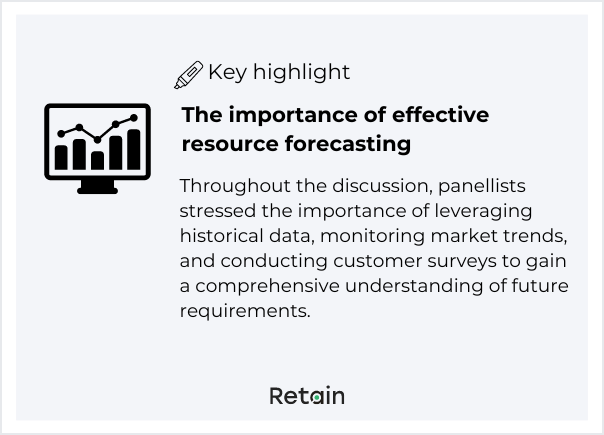
Throughout the discussion, panellists stressed the importance of leveraging historical data, monitoring market trends, and conducting customer surveys to gain a comprehensive understanding of future requirements.
They also advocated for cataloguing employee skills meticulously and leveraging scenario planning to prepare for uncertainties proactively.
The overarching message was clear: precise resource forecasting is the key to effective resource management, and organisations that prioritise this capability will be well-positioned to drive operational excellence, agility, and sustained growth. (For more insights on cutting-edge resource forecasting techniques, check out our comprehensive blog on the topic.)
Theme 3: Elevating resource management internally
The third major theme that resonated throughout RMGS 2024 was the ongoing challenge of proving the value of resource management and gaining sustained internal buy-in from leadership teams. As the panel moderated by Debra Olson of RTMC highlighted, even the most seasoned resource managers can find it difficult to build and maintain support for their function within organisations that may not immediately recognise its importance.
Panellists David Binnings (DocuSign), Rob Dal Bianco (Diebold Nixdorf), and Elaine Brady (Henny Penny) shared their experiences navigating this uphill battle, offering valuable insights on influencing resource management's growth and securing leadership commitment.
A key takeaway was the importance of establishing a strong governance capability to monitor and control the inputs and outputs of all resource management functions. By consistently measuring and reporting on the right metrics—whether it's resource utilisation, project profitability, or operational efficiency—resource management teams can tangibly demonstrate their impact on the bottom line.
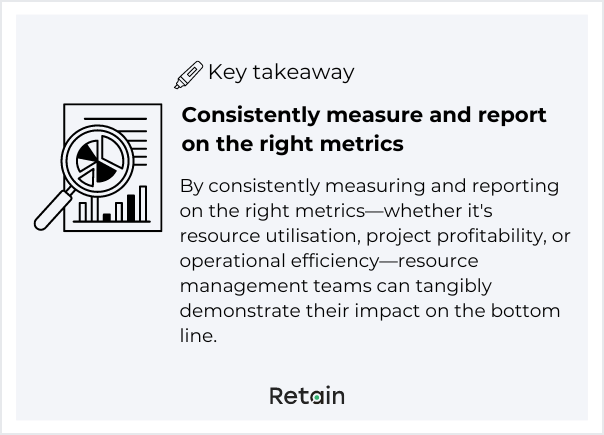
Greg Hensley of the RMI further emphasised the need for resource managers to prioritise their own professional development. His session outlined a framework for leveraging RMI's materials, tools, and training programs to hone skills, stay ahead of industry trends, and position yourself as an indispensable strategic asset within the organisation.
This theme struck a chord with many attendees who have faced similar challenges in advocating for their function's significance. As our own blog post on user experience in resource scheduling touches upon, a well-designed and intuitive resource management solution can go a long way in streamlining processes, improving accuracy, and boosting team engagement—all of which contribute to the overall perception and impact of the function.
Ultimately, the consensus was clear: resource managers must proactively tie their efforts directly to organisational goals and priorities. By leveraging data, developing expertise, and implementing user-friendly tools, they can solidify their position as strategic partners driving efficiency, productivity, and growth.
Theme 4: Trends in resource management technology
The fourth key theme at RMGS 2024 focused on trends in resource management technology. The panel discussion, moderated by Wade Little of RTMC, assembled industry leaders (including our very own Jamie Skuse, Head of Product Development at Retain) to share perspectives on where the market is heading.
Key trends discussed included the increasing adoption of AI for optimised resource allocation, how to prepare for AI, the pros and cons of AI, and the importance of building great teams.
Today AI is helping match demand with resource experience skills and relatable skills. As an example, here is a screenshot of one of Retain’s AI skills matching features;
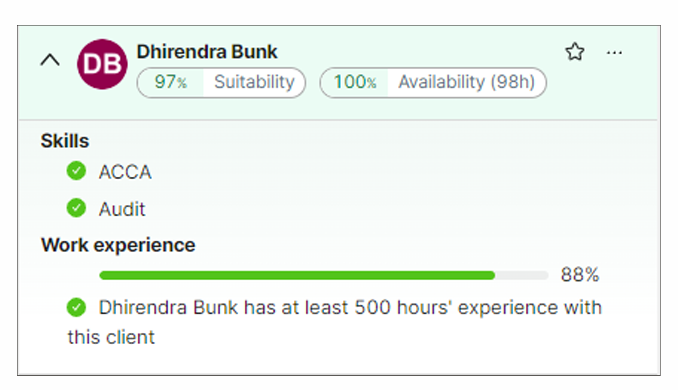
In the future, Conversational AI, like ChatGPT, will be used to deal with adhoc demand requests. This will help ensure all the criteria is captured, freeing up resource managers to focus on more complex requests.
AI will also provide data driven insights, allowing resource managers to focus on more strategic projects.
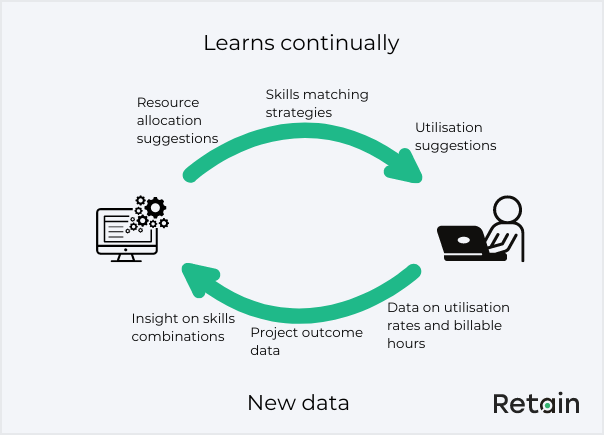
When it comes to preparing for AI implementation, of course, the outputs will only be as good as the data that is fed into the system. Jamie raised the importance of ensuring you maintain quality historic resourcing data on skills, experience, preferences, grades, and ratings.
As the discussion progressed, an important consideration emerged: the need to overcome the "black box" issue often associated with AI systems. While AI is great at processing vast amounts of data and identifying patterns, the complex algorithms and models involved can make the decision-making process opaque and difficult to explain.
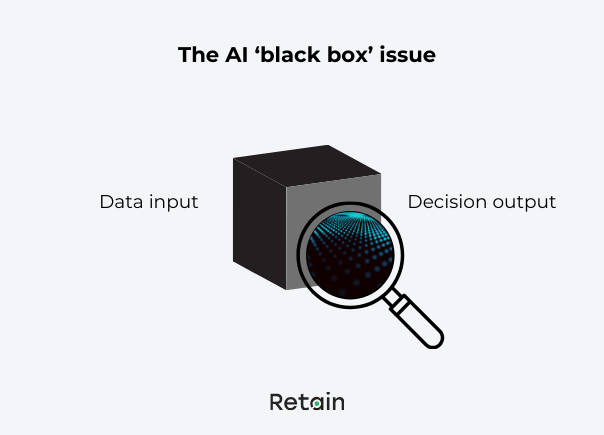
[You can read more about the pros and cons of AI in resource management here.]
To address this challenge, panellists stressed the importance of striking a balance between AI insights and human judgement. Successful AI implementation in resource management involves using AI as a powerful decision support tool, but not as the sole decision-maker.
Additionally, the panel highlighted the growing field of Explainable AI (XAI), which aims to make AI decision-making processes more transparent and understandable. This includes creating models that can provide reasoning for their decisions, developing tools to interpret AI outputs, and adhering to regulations that require AI transparency.
Jamie Skuse emphasised Retain's commitment to transparency, citing the importance of providing clear explanations for resource suitability matches, whether based on previous engagements, relevant experience, or specific transferable skills. This level of visibility helps fine-tune search criteria and reassures stakeholders that the results are fair, impartial, and aligned with client requirements.
The panellists were then asked about which features customers are asking for—and really need.
Jamie talked about specific industry feature requests such as:
Tax and Audit firms with seasonal planning
✅Mass roll forward including actuals & schedule optimisation
✅Engagement Governance
Consultancy firms
✅Skills analytics forecasting trends and future skills demand
✅Resource suitability matching replacements against a named resource
The final questions focused on what resource managers can look forward to in the near future. Jamie led the discussion by talking about a new way to use AI to build high-performing teams by understanding the nuances of team chemistry.
Understanding people's traits and soft skills allows you to understand the balance of a team. You can then discover which personality traits work well together allowing resource managers to create harmonious teams.
You can also mitigate any potential conflicts of interest where resources can’t or even don’t work well together. AI can then learn from historical data to predict a team’s chemistry and recommend a dynamic team which has improved team chemistry.
Wrap-up
As I reflect on the event, one thing is clear: the professionals in this field are at the forefront of driving innovation and digital transformation. I can't wait to see what the next year holds. Until then, it's time to put these insights into action and continue pushing the boundaries of what's possible.
As we look ahead, it's clear that resource management is no longer an operational function; it is a strategic imperative that can drive tangible business value. The integration of AI and machine learning, in particular, holds immense promise, enabling organisations to optimise resource allocation, enhance project outcomes, and future-proof their workforces.
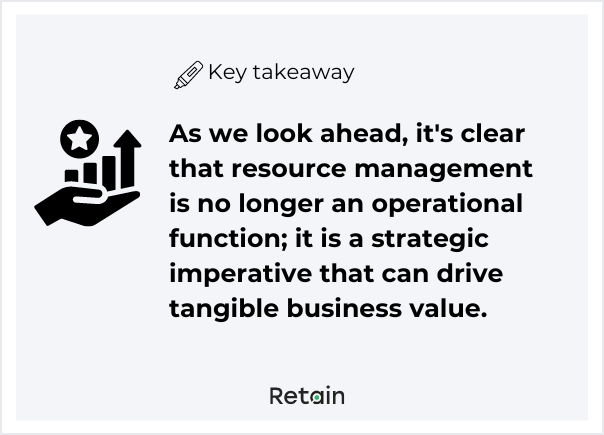
However, as discussions at RMGS 2024 highlighted, the path to AI-driven resource management is not without its challenges. Striking the right balance between machine intelligence and human expertise, ensuring transparency and explainability in decision-making processes, and navigating the ethical considerations of AI adoption are all critical factors that must be addressed.
For those seeking to stay ahead of the curve, the insights and connections forged at RMGS 2024 we’d love it if you follow us on LinkedIn.
If you’re interested in finding out more about market leading resource management technology, the best way to see some of these features in action is to join us for an introductory demo. Learn how our new features can help you find the right resources in a snap, use AI-powered skills matching, and more. Plus, get a chance to ask questions and share feedback in a live Q&A with me.
You can also keep up to date with the latest from Retain in our blog section and see what our thought-leaders have to say in our LinkedIn newsletter.


